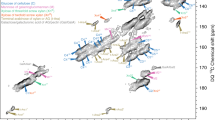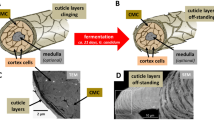Abstract
WOOL fibres consist mainly of long cortical cells filled with microfibrils, 7–8 nm diameter, embedded in a matrix. The microfibrils are composed of proteins with a lower sulphur content and a higher α-helix content than wool; the matrix proteins have a higher sulphur content than wool and no α helix1,2. When reduced and carboxymethylated low-sulphur proteins from wool (SCMKA) are separated by starch gel electrophoresis, there are two main bands, component 7 (molecular weight 46,000) and component 8 (molecular weight 51,000)3,4, and it has been suggested that the microfibrils are composed of regularly arranged macromolecules (molecular weight 143,000) consisting of two component 7 molecules and one component 8 molecule5.
This is a preview of subscription content, access via your institution
Access options
Subscribe to this journal
Receive 51 print issues and online access
$199.00 per year
only $3.90 per issue
Buy this article
- Purchase on Springer Link
- Instant access to full article PDF
Prices may be subject to local taxes which are calculated during checkout
Similar content being viewed by others
References
Bradbury, J. H., Adv. Protein. Chem., 27, 111–211 (1973).
Fraser, R. D. B., MacRae, T. P., and Rogers, G. E., Keratins, (Thomas. Springfield, Illinois, 1972).
Crewther, W. G., Fraser, R. D. B., Lennox, F. G., and Lindley, H., Adv. Protein Chem., 20, 191–346 (1965).
Jeffrey, P. D., J. Textile Inst., 63, 91–113 (1972).
Crewther, W. G., Dobb, M. G., Dowling, L. M., and Harrap, B. S., in Symposium on Fibrous Proteins, Australia 1967 (edit. by Crewther, W. G.), 329–340 (Butterworth, Sydney, 1968).
Campbell, M. E., Dobb, M. G., Hilburn, M. E., Loh, P., Lotay, S. S., Speakman, P. T., Stainsby, G., and Yarwood, R. E., in Proc. 5th Int. Wool Textile Res, Conf., Aachen. 2, 243–252 (1975).
Speakman, P. T., Nature, 250, 624 (1974).
Crewther, W. G. and Dowling, L. M., Appl. Polym. Symp., 18, 1–20 (1971).
Crewther, W. G., and Lennox, F. G., J. Proc. R. Soc. N.S.W., 108, 95–110 (1975).
Skerrow, D., Matoltsy, A. G., and Matoltsy, M. N., J. biol. Chem., 248, 4820–4826 (1973).
Skerrow, D., Biochem. biophys. Res. Commun., 59, 1311–1316 (1974).
Lee, L. D., Fleming, B. C., Waitkus, R. F., and Baden, H. P., Biochim. biophys. Acta, 412, 82–90 (1975).
Steinert, P. M., Biochem. J., 149, 39–48 (1975).
Hilburn, M. E., Speakman, P. T., and Yarwood, R. E., Biochim. biophys. Acta., 214, 245–247 (1970).
Morris, C. J. O. R., and Morris, P., Separation methods in Biochemistry, 837 (Pitman, London, 1976).
Horn, M. J., Jones, D. B., and Ringel, S. J., J. biol. Chem., 138, 141–149 (1941).
Ziegler, K., J. biol. Chem., 239, PC2713–2714 (1964).
Speakman, P. T., and Yarwood, R. E., Nature, 211, 201–202 (1966).
Author information
Authors and Affiliations
Rights and permissions
About this article
Cite this article
LOTAY, S., SPEAKMAN, P. Three-chain merokeratin from wool may be a fragment of the microfibril component macromolecule. Nature 265, 274–276 (1977). https://doi.org/10.1038/265274a0
Received:
Accepted:
Issue Date:
DOI: https://doi.org/10.1038/265274a0
Comments
By submitting a comment you agree to abide by our Terms and Community Guidelines. If you find something abusive or that does not comply with our terms or guidelines please flag it as inappropriate.



